
Please wait, I'm coming over...

Last Changed 3/4/2017 |
||
|
We started our information search on building a highly functional air-card
internet system by read
Jack Mayer's topic on
Communications on the Road.
These are the decisions we made in configuring our air-card system.. If you are not well versed in household wiring, look at Electrical Basics for some fundamental information. |
||
The Wireless Carrier |
||
|
We have been Verizon users for our cellphones for quite a while. After doing
a area coverage comparison between the major
carriers, we again convinced ourselves that Verizon was the wireless carrier we wanted
for our air-card. Choosing Verizon Wireless as a carrier does not require that Verizon be the contractor for the subscription. After a lot of searching, we found that Millenicom offered a subscription with 10GB/month of data allocation for the same amount that Verizon charged for 5GB/month. On the Millenicom site, it does not state that Verizon is the carrier of the 10GB/month plan but research found than indeed Verizon is the carrier but Millenicom can't use the name in marketing. (Note - Millenicom raised the data allocation for our plan to 20GB/month) The subscription contracts usually have a two-year requirement to cover the cost of the air-card modem subsidization. Some contacts have no requirement. A no-requirement contact can work two ways. You can leave the subscription anytime and the subscription leave you likewise. The installation of our air-card system. |
||
Our Air-Card Modem (3G) |
||
|
Selecting an air-card modem generally follow the selection of the carrier and the
contractor. Air-card modems can be quite expensive if purchased outright.
Air-card modems are treated like cellphones, the price is subsidized by the contractor
in the subscription package. The subsidization can be from the entire cost to
a major portion of the air-card modem cost. |
||
 |
For the 10gb data plan from Millenicom, you buy a
Novatel U760 air-card modem for $99.
With the purchase of the U760, there is no contact requirement after
a $50 setup fee. The U760 was the only air-card modem offered but it was about the most wanted modem at the time. A key feature we wanted in the air-card modem was an external antenna connection port. |
|
Our local LAN |
||
 |
With the three PCs, we also have a LAN printer. When we are on the
air-card, we use wired and wireless connections to our wireless
router which the air-card modem is plugged into. The local LAN allows
us to share files and the printer. When we used PC wireless connections to park Wi-Fi, we lost connection to our printer and shared file store, an inconvenience. By using a Deliberant radio to establish the park Wi-Fi connection, we retain our local LAN just like on the air-card modem. |
|
click on image to enlarge |
||
The Air-Card Router |
||
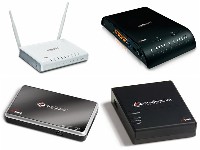 |
While we could use the air-card modem in one of the PCs when we are
driving down the road, we really needed the air-card modem to be attached
to a local LAN. The best way to do this is with an air-card
router. Air-card routers have the additional connections to
allow an air-card modem to be plugged into the router and additional
logic to manage the air-card modem to make and break connections. Our research found the best rated air-card routers to be CradlePoints. MBR350, , MBR900, and MBR1200 shown. |
|
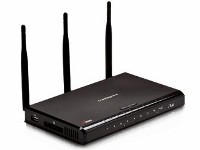 |
For reasons of strong signal and 802.11N spec protocol, we choose the
CradlePoint MBR-1000.
The
has over twice the range of the lower end CradlePoint routers and offers the 802.11N spec. There is a high end CradlePoint router, the MBR-1200, but the extra features of the MBR-1200 were features we didn't need. |
|
The Amplifier (3G) |
||
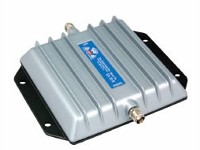 |
There are wireless amplifiers which have small interior antennas that communicate with the air-card modem and an external antenna that communicates with the cell tower. These could be used with cellphones as well as the air-card modem. While this may seem to be a better solution, there are complications. First, the optimal power connection to the cell tower is with a wired amplifier. The more difficult complication is that the interior and external antennas have to have a wide separation since they both are operating on the same frequencies. With a building this can relatively easy, with an RV, this is very hard. This is the CYFRE 819 wired amplifier. . |
|
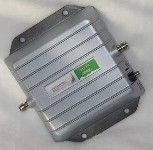 |
We choose the
Peak Reception "Rockies" model
amplifier,
mainly for
the stronger available signal. You have to know the amplifier adjusts it power to meet the needs of the cell tower. For example, with a close cell tower, the amplifier power will be reduced. This is done to prevent overpowering the cell tower. |
|
The Antenna |
||
 |
There several options for antennas to extend the air-card modem.
Some are smaller in size and can be fixed mounted. Longer antennas
offer more power but cannot be fixed mounted. This is a 18" Shorty RV Through-Roof Antenna. |
|
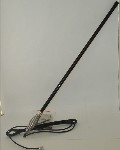 |
We choose a 9DB Super Trucker Antenna . We are mounted the whip on the support arms of our Winegard Sensar TV antenna. When we elevated the Sensar (batwing) antenna, the wireless antenna will also be elevated. | |
The Change to 4GChanging to using 4G Wireless involved a lot of equipment changes. |
||
Our Air-Card Modem (4G) |
||
|
When we switched to 4G using Millenicom as our provider, we received
a Pantech MH290 Jetpack, a MiFi device. A MiFi is a
combination of an air-card modem and a router. We could use the
MH290 on an USB cable plugged into our new router or use WiFi
to connect out new router. It turned out than while the belief
that the USB cable would be faster, the WiFi connection was faster. |
||
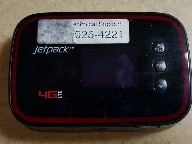 |
We had wanted to use the USB cable connection so that power would be
supplied to the MH290. We did use an USB cable just for power
and used WiFi for the signal connection to the router. The Pantech MH290 had a flaw in that constant power would cook the battery causing it to fail. Since we use the Internet all the time, counting on battery power was not an acceptable solution. |
|
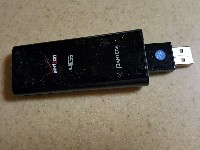 |
Our solution was to remove the SIM card from the MH290 and put it into a Pantech UML295 air-card modem. The UML295 does nor use batteries and receives its power from the USB cable. | |
The Air-Card Router (4G) |
||
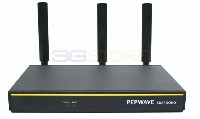 |
Our CradlePoint MBR-1000 did a good job as a 3G router but it did not support 4G connections. We chose a Surf Pepwave SOHO router. It had a few more features that the CradlePoint and did support 4G. | |
The Amplifier (4G) |
||
| In the few years we had the high-power 3G amplifier, we only used it once. We decided not to incur the same kind of cost for our 4G configuration. | ||
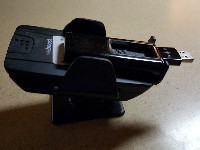 |
We chose to use a WeBoost Drive 4G-S Sleek amplifier. It uses a cuff to hold the phone, or, in our case, air-card modem. It does have the same amplification power but it has delivered enough for us. . |
|
The Antenna (2) |
||
|
The change in antenna was due to the change of traveling with our Bounder, Joey.
We did not have a batwing TV antenna on the Bounder like we had on
the trailer. We wanted an antenna that could stay elevated all
the time. We wanted the air-card antenna to be shorter than
the air conditioner covers on the roof. We chose to use a
BoatAnt, a short but very high gain antenna. |
||
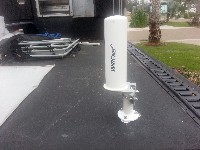 |
The antenna and the mounting we used is covered in 4G Antenna Mount | |
Disclaimer: The information in this site is a collection of data we derived from the vendors and from our personal experiences. This information is meant as a learning guide for you to make your own decisions Best practices and code should always be followed. The recommendations we make are from our personal experiences and we do not receive any compensation for those recommendations. |